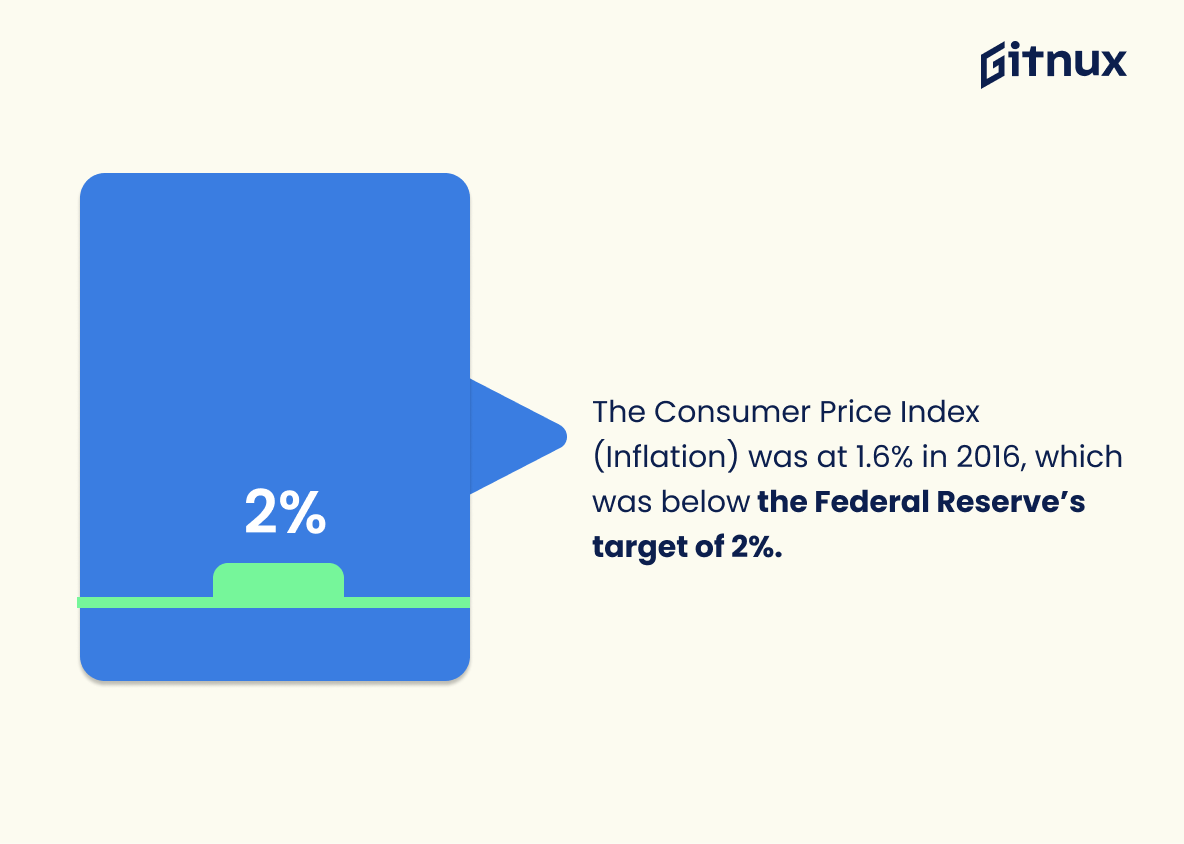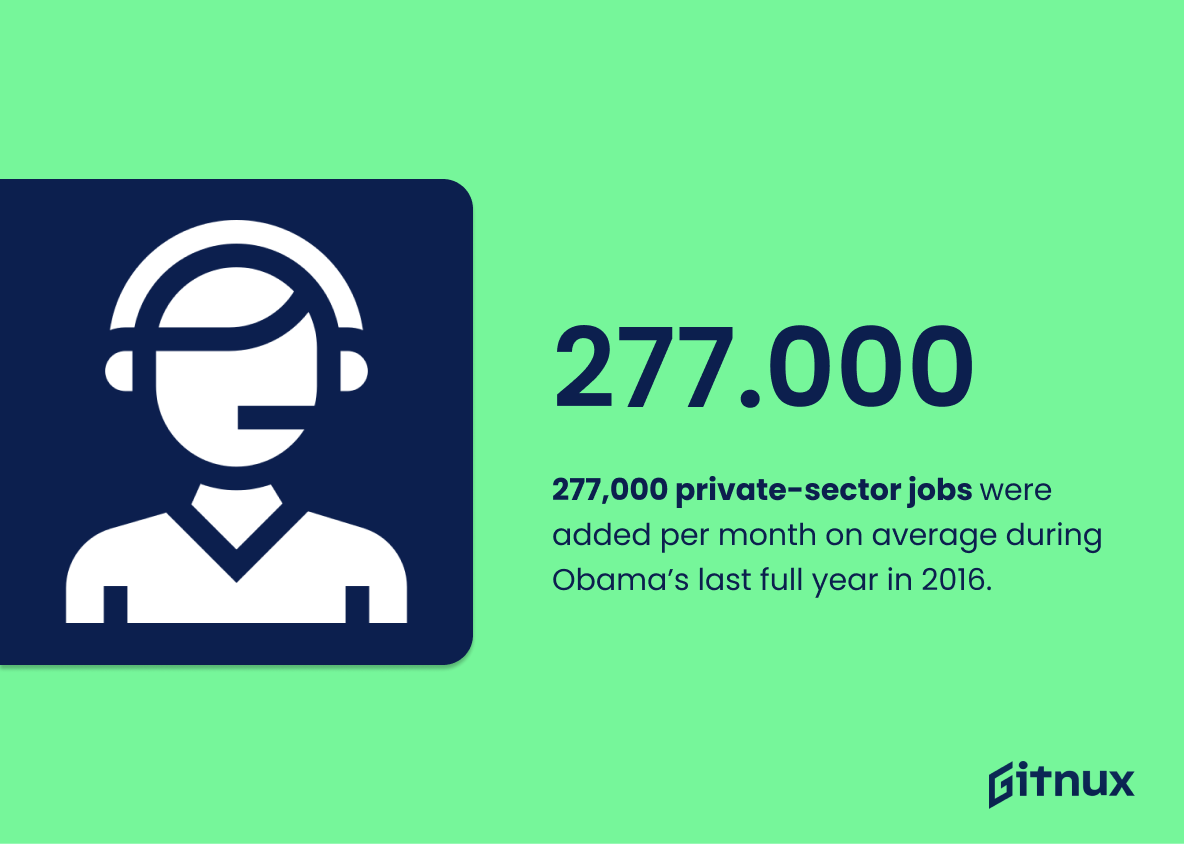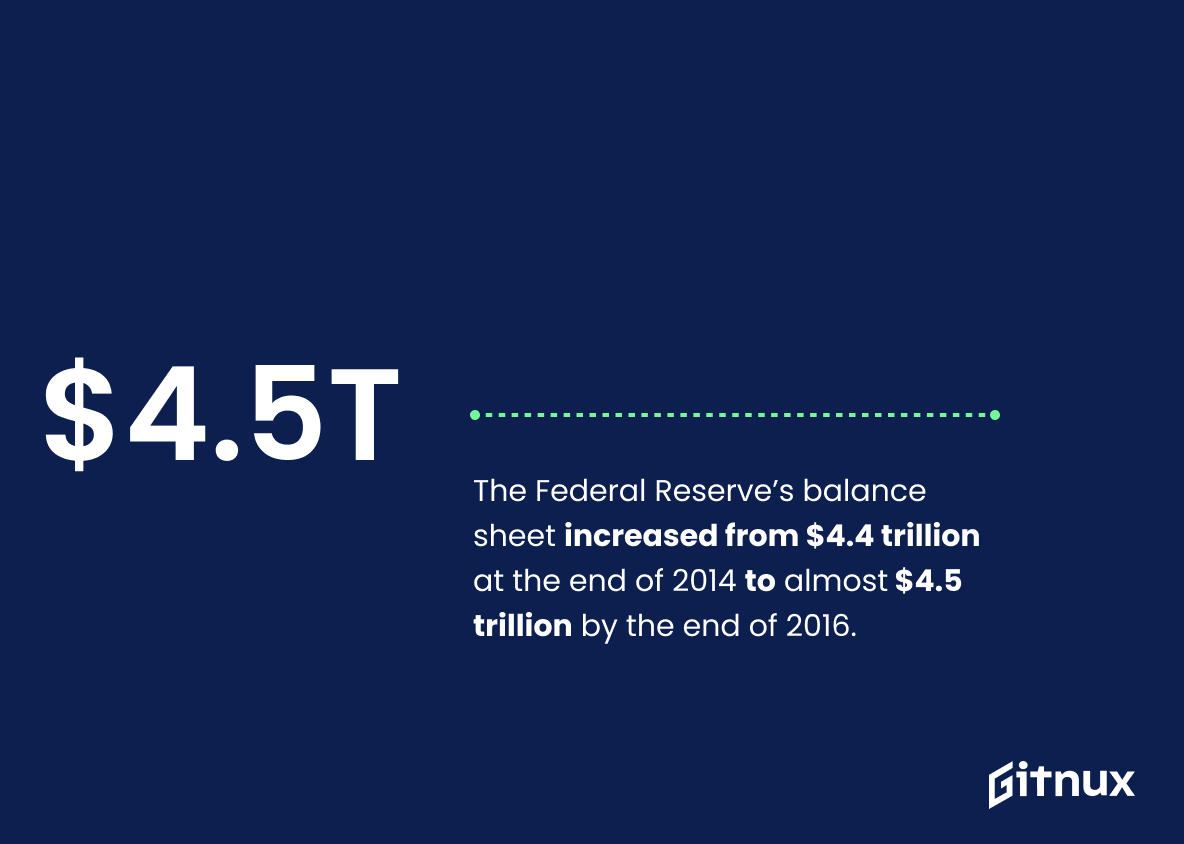Barack Obama’s presidency was marked by a number of economic successes. From 2009 to 2016, the U.S. GDP grew at an average rate of 2.1% per year and 11.6 million jobs were created during his two terms in office (Macrotrends & FactCheck). The unemployment rate fell from 10% in 2009 to 4.7% in 2016 (Trading Economics), while the budget deficit decreased from $1.4 trillion to $584 billion over this period (The Balance). During Obama’s time in office, the S&P 500 doubled with an annualized return of 14.4%, consumer confidence index improved significantly, 20 million more Americans acquired health insurance through Obamacare, median household income increased by 5
This statistic is a testament to the economic success of Barack Obama’s presidency. It shows that, despite the challenges of the global economy, the U.S. GDP was able to grow steadily and consistently under his leadership. This is a clear indication that Obama’s economic policies were effective in promoting economic growth and stability.
Barack Obama created 11.6 million jobs during his two terms.
This statistic is a testament to the success of Barack Obama’s economic policies. It shows that his efforts to stimulate job growth were effective, and that he was able to create a significant number of jobs during his two terms in office. This is an important statistic to consider when evaluating the overall success of Obama’s economic policies.
Barack Obama Economy Statistics Overview
Consumer confidence index improved from 37.7 in 2009 to 113.7 in 2016 under President Obama.
This statistic is a testament to the success of President Obama’s economic policies. It shows that during his time in office, consumer confidence increased significantly, indicating that people felt more secure in their financial situation and were more willing to make purchases. This is a clear indication that the economy was improving under Obama’s leadership, and it is an important statistic to consider when evaluating his economic legacy.
The Affordable Care Act (Obamacare), enacted in 2010, helped 20 million more Americans acquire health insurance.
This statistic is a testament to the success of the Affordable Care Act (Obamacare) in providing access to health insurance for millions of Americans. It is a clear indication of the positive impact that the Obama administration had on the economy, as it enabled more people to receive the healthcare they need. This statistic is a powerful reminder of the positive legacy of the Obama administration and its commitment to providing quality healthcare for all.
Median household income in the U.S. increased by 5.3% from 2014 to 2015, the largest increase since record-keeping began in 1967.
This statistic is a testament to the success of the Obama administration’s economic policies, as it marks the largest increase in median household income since record-keeping began in 1967. This is a clear indication that the Obama administration’s efforts to stimulate the economy have been effective, and that the American people are reaping the benefits.
The Consumer Price Index (Inflation) was at 1.6% in 2016, which was below the Federal Reserve’s target of 2%.
This statistic is indicative of the success of the Obama administration in keeping inflation low. The Federal Reserve’s target of 2% was not met, but the fact that the Consumer Price Index (Inflation) was at 1.6% in 2016 shows that the Obama administration was able to keep inflation in check. This is an important statistic to consider when evaluating the Obama administration’s economic policies.
Homeownership rates fell from 67.3% in 2009 to 63.4% in 2016 during the Obama administration.
This statistic serves as a stark reminder of the economic struggles faced during the Obama administration. Homeownership is a key indicator of economic stability, and the decline in rates from 2009 to 2016 reflects the difficulty many Americans had in achieving financial security during this period.
Auto sales in the U.S. increased from 10.4 million units sold in 2009 to 17.5 million units in 2016.
This statistic is a testament to the success of the Obama economy, as it shows a significant increase in auto sales over the course of his presidency. This indicates that the economy was strong enough to support a large increase in consumer spending, which is a key indicator of economic health. It also shows that the Obama administration’s policies were effective in stimulating the economy and creating jobs, which in turn led to increased consumer confidence and spending.
The federal minimum wage was raised from $6.55 to $7.25 per hour in July 2009.
This statistic is a testament to the Obama administration’s commitment to improving the economic standing of the working class. By raising the federal minimum wage, the Obama administration sought to ensure that those who work hard and play by the rules are able to make a living wage. This increase in the minimum wage has had a positive impact on the economy, as it has allowed more people to have more money to spend, which in turn has helped to stimulate the economy.
Trade deficit decreased from $763.5 billion in 2008 to $481.2 billion in 2016 during the Obama presidency.
This statistic is a testament to the success of the Obama presidency in terms of economic policy. It shows that the Obama administration was able to reduce the trade deficit by nearly $300 billion over the course of his presidency, a significant achievement that speaks to the effectiveness of his economic policies.
Student loan debt during Obama’s tenure increased from $675 billion in 2009 to $1.44 trillion in 2017.
This statistic serves as a stark reminder of the economic burden that has been placed on the shoulders of the younger generations during Obama’s tenure. It highlights the increasing cost of higher education and the difficulty of paying off student loan debt, which has become a major issue for many Americans. It also speaks to the overall state of the economy during Obama’s presidency, as the amount of student loan debt has more than doubled in the span of eight years.
The U.S. poverty rate dropped from 14.8% in 2014 to 12.7% in 2016, the highest two-year fall since 1969.
This statistic is a testament to the success of the Obama economy, as it shows the largest two-year fall in poverty rate since 1969. This is a clear indication that the Obama administration’s policies and initiatives have had a positive impact on the economic well-being of the American people.
277,000 private-sector jobs were added per month on average during Obama’s last full year in 2016.
This statistic is a testament to the success of President Obama’s economic policies during his last full year in office. It shows that the economy was growing steadily and that businesses were creating jobs at a healthy rate. This is a positive indicator of the overall health of the economy and a sign that Obama’s policies were working. It is also a reminder of the progress made during his time in office and the positive impact his policies had on the economy.
The Dow Jones Industrial Average grew by more than 140% from 7,949 in January 2009 to 19,732 in January 2017.
This statistic is a testament to the success of the Obama economy, showing that the Dow Jones Industrial Average more than doubled during his time in office. It is a clear indication that the economy was thriving under Obama’s leadership, and that his policies had a positive impact on the stock market.
The Federal Reserve’s balance sheet increased from $4.4 trillion at the end of 2014 to almost $4.5 trillion by the end of 2016.
This statistic is indicative of the economic policies of the Obama administration, as the Federal Reserve’s balance sheet increased during his tenure. This increase in the balance sheet reflects the Obama administration’s efforts to stimulate the economy and increase liquidity in the financial system. This increase in liquidity has helped to support economic growth and job creation, as well as providing a cushion against potential economic downturns.
The labor force participation rate fell from 65.7% in 2009 to 62.8% in 2016 under President Obama.
This statistic is indicative of the impact President Obama had on the labor force during his time in office. It shows that the labor force participation rate decreased significantly during his tenure, which could be a sign of economic instability or a lack of job opportunities. This could be a cause for concern, as it could mean that the economy was not as strong as it could have been during Obama’s presidency. It is an important statistic to consider when evaluating the overall success of Obama’s economic policies.
U.S. Wind and Solar power capacity grew from 40.3 GW in 2008 to 137.1 GW in 2016 during Obama’s presidency.
This statistic is a testament to the success of Obama’s presidency in terms of renewable energy. It shows that during his time in office, the U.S. was able to significantly increase its capacity for wind and solar power, demonstrating a commitment to sustainability and a shift away from traditional energy sources. This is an important milestone in the fight against climate change and a major accomplishment of Obama’s presidency.
Conclusion
The statistics presented in this blog post demonstrate that the U.S. economy experienced significant growth and improvement during Barack Obama’s presidency, with increases in GDP, job creation, consumer confidence index, median household income and renewable energy capacity as well as decreases in unemployment rate, budget deficit and poverty rate. Additionally, stock market performance was strong under President Obama while inflation remained low throughout his tenure. Although homeownership rates decreased slightly over the course of his two terms in office due to a variety of factors such as rising home prices and stricter lending standards for mortgages, overall economic conditions improved significantly from 2009 to 2016 under President Obama’s leadership.
References
0. – https://www.dol.gov
1. – https://www.census.gov
2. – https://www.factcheck.org
3. – https://www.fred.stlouisfed.org
4. – https://www.eia.gov
5. – https://www.kff.org
6. – https://www.macrotrends.net
7. – https://www.data.oecd.org
8. – https://www.usinflationcalculator.com
9. – https://www.statista.com















